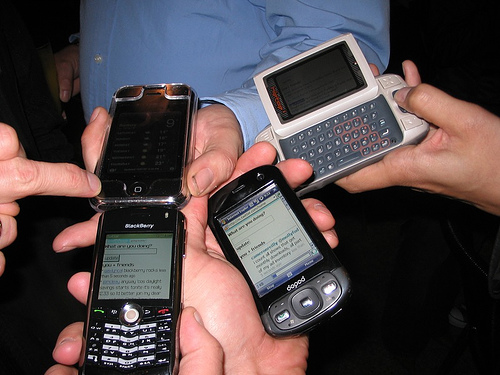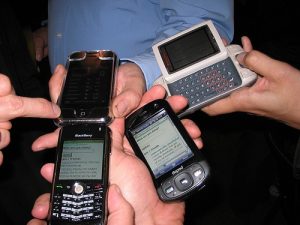Wireless “Spectrum” as a Latino Consumer Issue

 By Jason Llorenz, LIN@R
By Jason Llorenz, LIN@R
The rapid advance of wireless innovation has put power once requiring a room full of air conditioned computers into our palms, purses and pockets. This innovation has also crowded the airwaves as more and more high-powered devices compete for airwaves limited by outmoded government policies. The spectrum crunch is one of one of America’s most pressing consumer concerns, especially for Hispanics.
 Understanding Wireless Spectrum
Understanding Wireless Spectrum
Spectrum refers to the frequencies (or “channels”) of airwaves that allow wireless devices to communicate with one another. In the case of the miraculous wireless phones and tablets increasingly central to our lives, spectrum is lifeblood, required to transmit packets of data and voice from a device to the nearest tower, and vice versa.
An area without adequate spectrum to serve its users means dropped calls, long download times and frustration. This situation is happening more often, in more places, especially in the most populated areas, which also boast the largest Latino populations.
America’s spectrum policy challenge threatens the mobile technology that has empowered millions of people, and offers solutions to the challenges of civic engagement, health disparities and high quality education.
Congress and the FCC are in the midst of revising outdated spectrum policies that no longer serve us well. Decades before the first cell phone, when the closest thing to a smartphone in the American consciousness was Captain Kirk’s tricorder, the airwaves were licensed haphazardly to television broadcasting, military and some other uses.
Some swaths of spectrum were left vacant, others reserved for government…the airwaves were perceived as wide open, and easily apportioned. These outdated policies have left only a sliver of spectrum channels available for wireless devices, even as television broadcasting has moved away from broadcasting to digital cable, and we rely increasingly on spectrum-hungry devices for news, communication and entertainment.
Rapid innovation has exploded our spectrum needs more quickly than every estimate. The advent of the wireless industry in the 1980s required spectrum to allow the first cellphones to connect basic wireless telephone calls. The 1990s brought wireless personal communication to millions. In the 2000s, the IPhone made wireless Internet a consumer necessity.
Today, we expect and rely upon lightning fast video on demand (and this year, FaceTime video calls) from anywhere. The app market, which didn’t exist about 5 years ago, provides high- intensity apps that require bandwidth and instant communication from high-speed networks, requiring more and more spectrum availability as we move toward the majority of wireless users choosing fully web-enabled, powerful smartphones over the old style, basic flip phone.
Last year, the majority of mobile devices sold were smartphones. We love the mobile experience so much, large-screen smart devices (or tablets – which are really just iPhones and droids with a screen fit for movies, television, books and so much more.) were developed, which rely even more on the same mobile networks for mobility and productivity.
Despite the innovation driven by exploding demand, the vast majority of spectrum remains apportioned to government and to broadcasters. The airwaves are getting more crowded daily.
Latinos and Mobile
The Pew Internet and American Life Project, which studies use of the Internet by race, ethnicity and wealth report Latinos lead America in wireless Internet use, device ownership and use of wireless devices across activities. Wireless communications have helped bridge the wealth divide that holds so many families from investing in a home broadband connection — offering families access to devices offering convenience, cost advantage, and, increasingly powerful tools.
The Latino wireless story is one of political, business and cultural empowerment. As The Hispanic Institute and Mobile Future reports, no population has more to gain from the advent of mobile government and other services than the Hispanic population. Latinos choose the mobile platform, and leverage that platform across their lives in contrast to the ongoing digital divide in home broadband adoption percent of Latino homes have a home broadband connection, versus 66 percent of white homes, according to Pew).
The “spectrum” crunch threatens mobile innovation and Latino access
The spectrum crunch could result in more stringent data caps and higher prices for data without swift enough action to make more spectrum available to wireless users. This is of special concern for the large number of Latinos and others who rely on a wireless device for their main connection to the Internet.
As important as a new bus or subway line connecting one side of town to another, wireless broadband is the invisible infrastructure of commerce, facilitating business and opportunity in cities and in the hardest to reach places. The spectrum crunch threatens this beneficial technology with barriers that can be avoided.
What Policymakers Are Doing
In response to growing demand for action, Congress passed a law empowering the FCC to conduct reverse auctions of broadcast spectrum. The legislations creates a process for broadcasters to surrender their spectrum to the FCC for auction, some of the proceeds of which may be used to reposition the broadcaster to another channel[1], or simply allow the licensee to stop broadcasting and benefit from the ultimate sale.
The FCC is at the beginning of that auction process. Recently, Chairman Genachowski reported that the FCC is on track for releasing 300 MHZ of spectrum by 2015. With the rapid pace of increasing use of mobile, 300 MHZ may not provide enough spectrum to ensure an unimpeded path for mobile to achieve its potential. The largest channels of underutilized spectrum still lay with government agencies.
For Latinos, the spectrum crunch is one of the least discussed consumer issues. Yet government inaction or slow movement threatens the community’s key economic and social infrastructure – infrastructure that has grown to serve as a beneficial equalizer.
Jason A. Llorenz, Esq. is an advocate and speaker on American innovation, access to technology and digital literacy. He serves as an advisor to the Mobile Future coalition. Follow on twitter @llorenzesq. Linkedin.com/in/Jasonllorenz.
[1] This process of moving stations from one channel of spectrum to another is called “repacking” which is necessary in some cases to clear the pairs of channels necessary to make spectrum useful to wireless. While a broadcaster may broadcast “down” on channel 54, for example, a wireless devices would need paired access to channel 54 and 55 to send signals both ways – from tower and device.
This article was first published in LIN@R.
[Photo by Sue Waters]
